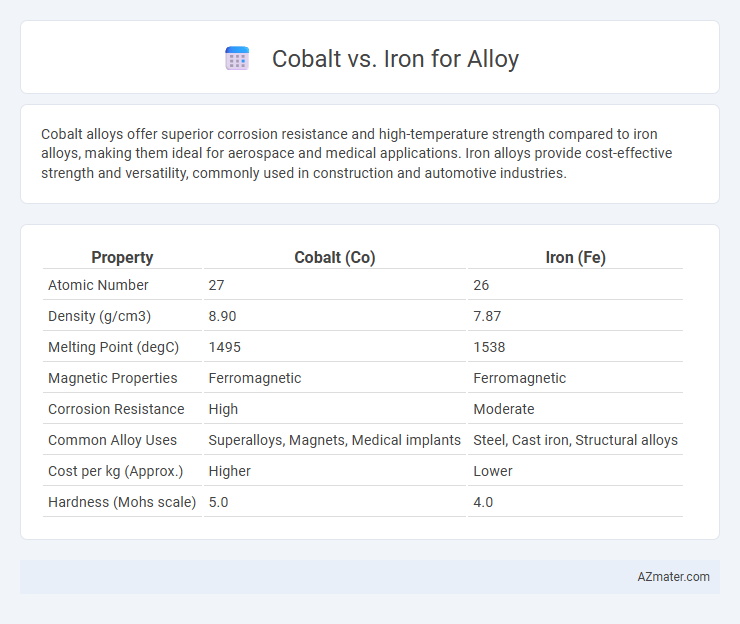Cobalt alloys offer superior corrosion resistance and high-temperature strength compared to iron alloys, making them ideal for aerospace and medical applications. Iron alloys provide cost-effective strength and versatility, commonly used in construction and automotive industries.
Table of Comparison
| Property | Cobalt (Co) | Iron (Fe) |
|---|---|---|
| Atomic Number | 27 | 26 |
| Density (g/cm3) | 8.90 | 7.87 |
| Melting Point (degC) | 1495 | 1538 |
| Magnetic Properties | Ferromagnetic | Ferromagnetic |
| Corrosion Resistance | High | Moderate |
| Common Alloy Uses | Superalloys, Magnets, Medical implants | Steel, Cast iron, Structural alloys |
| Cost per kg (Approx.) | Higher | Lower |
| Hardness (Mohs scale) | 5.0 | 4.0 |
Introduction: The Importance of Cobalt and Iron in Alloys
Cobalt and iron are critical elements in alloy production, each offering unique properties that enhance material performance. Cobalt alloys provide exceptional wear resistance, high-temperature strength, and corrosion resistance, making them ideal for aerospace and medical applications. Iron, primarily found in steel alloys, delivers excellent strength, affordability, and magnetic properties, which dominate construction and manufacturing industries.
Chemical and Physical Properties of Cobalt and Iron
Cobalt exhibits superior corrosion resistance and maintains magnetic properties at higher temperatures compared to iron, making it ideal for high-performance alloys. Iron, predominantly used in steel production, offers excellent tensile strength and ductility but is prone to oxidation and corrosion without protective coatings. Chemically, cobalt has a higher melting point (1495degC) than iron (1538degC) and exhibits greater stability in acidic environments, enhancing alloy durability and performance in extreme conditions.
Historical Use of Cobalt vs Iron in Metallurgy
Cobalt and iron have been pivotal in metallurgy for centuries, with iron widely utilized since ancient times due to its abundance and ease of extraction, leading to the Iron Age's technological advancements. Cobalt's historical use emerged later, primarily in blue pigments and later as an alloying element to enhance hardness, wear resistance, and corrosion resistance in high-performance steels. The evolution of cobalt's role in alloys marks a significant shift from decorative to functional applications, contrasting iron's foundational presence in tools, weapons, and infrastructure.
Alloy Formation: How Cobalt and Iron Behave Differently
Cobalt forms alloys with superior resistance to corrosion and high-temperature stability due to its hexagonal close-packed crystal structure, which enhances mechanical strength and thermal stability. Iron, typically body-centered cubic or face-centered cubic, excels in magnetic properties and is more prone to oxidation, impacting alloy durability. The distinct atomic arrangements and bonding characteristics of cobalt and iron dictate their alloy formation behaviors, influencing applications in aerospace, medical implants, and magnetic devices.
Strength, Hardness, and Durability Comparisons
Cobalt alloys exhibit superior strength and hardness compared to iron alloys, making them ideal for high-stress applications such as aerospace and medical implants. The exceptional wear resistance and corrosion durability of cobalt-based alloys outperform iron counterparts, ensuring longer lifespan in harsh environments. While iron alloys offer good mechanical properties at a lower cost, cobalt alloys provide enhanced performance in terms of tensile strength, hardness, and resistance to thermal degradation.
Magnetic Properties: Cobalt vs Iron Alloys
Cobalt alloys exhibit higher magnetic coercivity and retain magnetization better than iron alloys, making them ideal for permanent magnet applications. Iron alloys typically offer higher magnetic permeability and saturation flux density, which enhances their performance in transformer cores and electrical motors. The choice between cobalt and iron alloys depends on the required balance between magnetic strength, thermal stability, and corrosion resistance in specific industrial uses.
Corrosion Resistance in Cobalt and Iron-Based Alloys
Cobalt-based alloys exhibit superior corrosion resistance compared to iron-based alloys due to their stable passive oxide layer, which protects against oxidation and chemical attack in harsh environments. Iron-based alloys, while cost-effective and commonly used, typically require additional surface treatments or alloying elements such as chromium to enhance their corrosion resistance. The enhanced durability of cobalt alloys makes them ideal for applications in aerospace, medical implants, and marine environments where long-term corrosion resistance is critical.
Cost and Availability: Economic Considerations
Cobalt is significantly more expensive than iron due to its scarcity and complex extraction processes, driving up alloy production costs. Iron benefits from widespread availability and lower mining expenses, making it the preferred choice for cost-sensitive alloy applications. Economic considerations often favor iron alloys in large-scale manufacturing, while cobalt alloys are reserved for specialized uses requiring superior performance despite higher costs.
Common Applications in Industry and Technology
Cobalt alloys are extensively used in aerospace and medical implants due to their exceptional resistance to high temperatures and corrosion, whereas iron alloys dominate construction and automotive industries for their strength and cost-effectiveness. Cobalt's magnetic properties make it crucial in electronic components such as hard drives and batteries, while iron-based alloys are fundamental in manufacturing machinery and tools. The choice between cobalt and iron alloys hinges on application-specific needs like thermal stability, magnetic performance, and economic factors.
Future Trends in Cobalt and Iron Alloy Development
Cobalt and iron alloys are evolving with advancements in high-temperature and corrosion-resistant applications, where cobalt's superior strength and thermal stability drive demand in aerospace and medical implants. Innovations in iron-based alloys, particularly through additive manufacturing and nano-scale alloying, enhance their lightweight and magnetic properties, positioning iron as a sustainable and cost-effective choice for automotive and energy sectors. Future trends emphasize cobalt-iron composite materials leveraging their synergistic properties for next-generation batteries and superalloys, aiming to optimize performance while addressing resource scarcity and environmental impact.

Infographic: Cobalt vs Iron for Alloy
 azmater.com
azmater.com